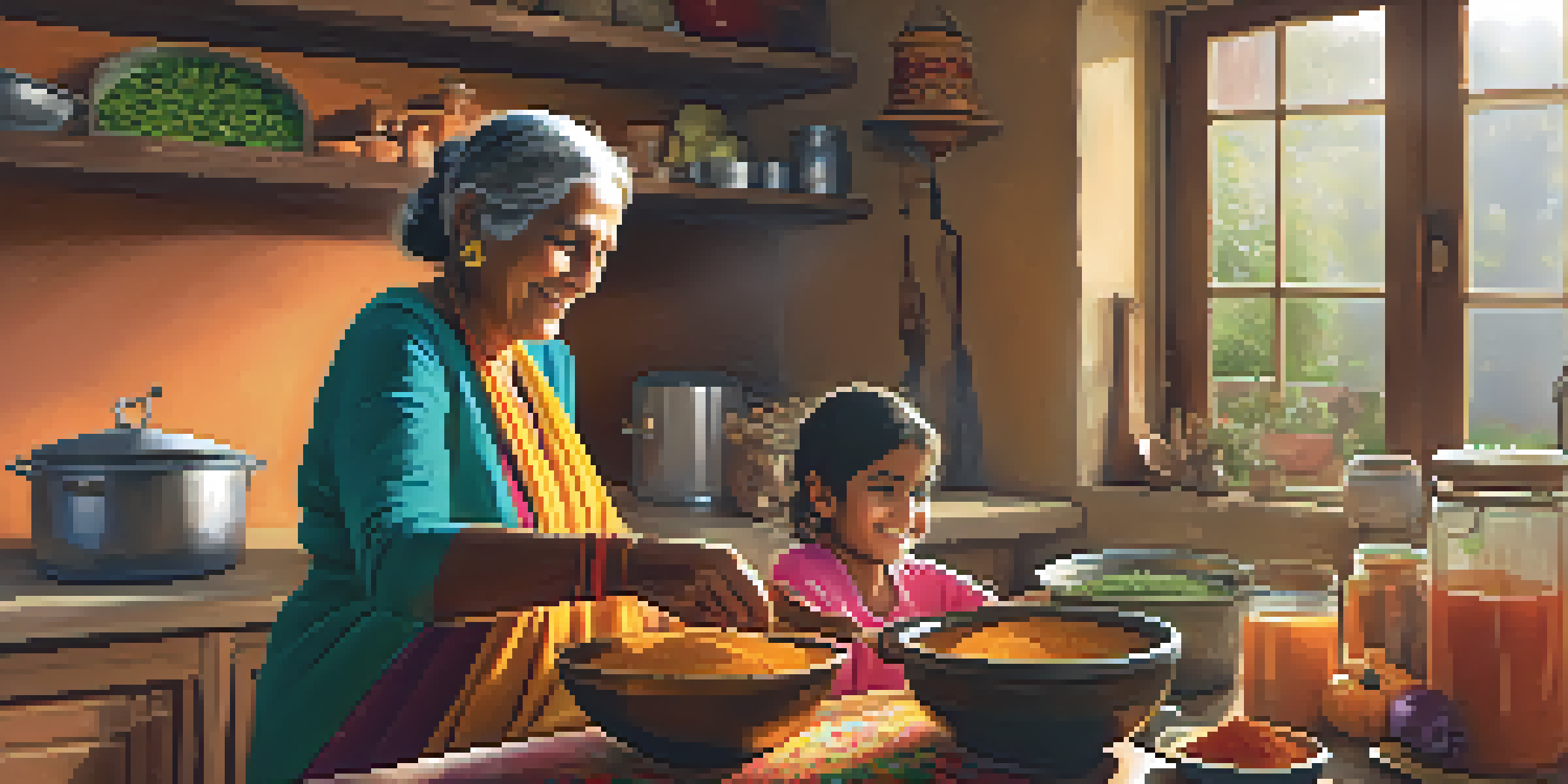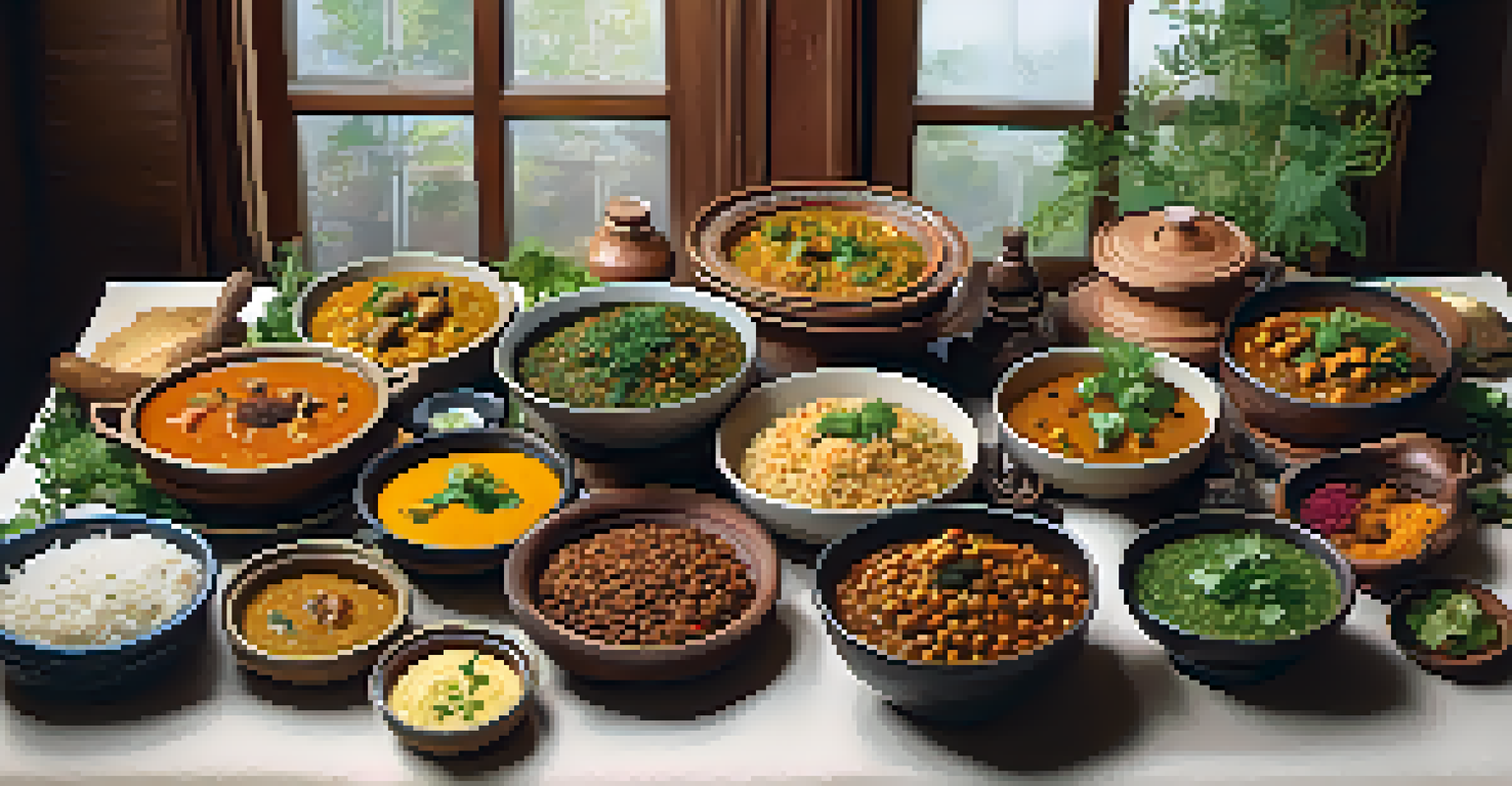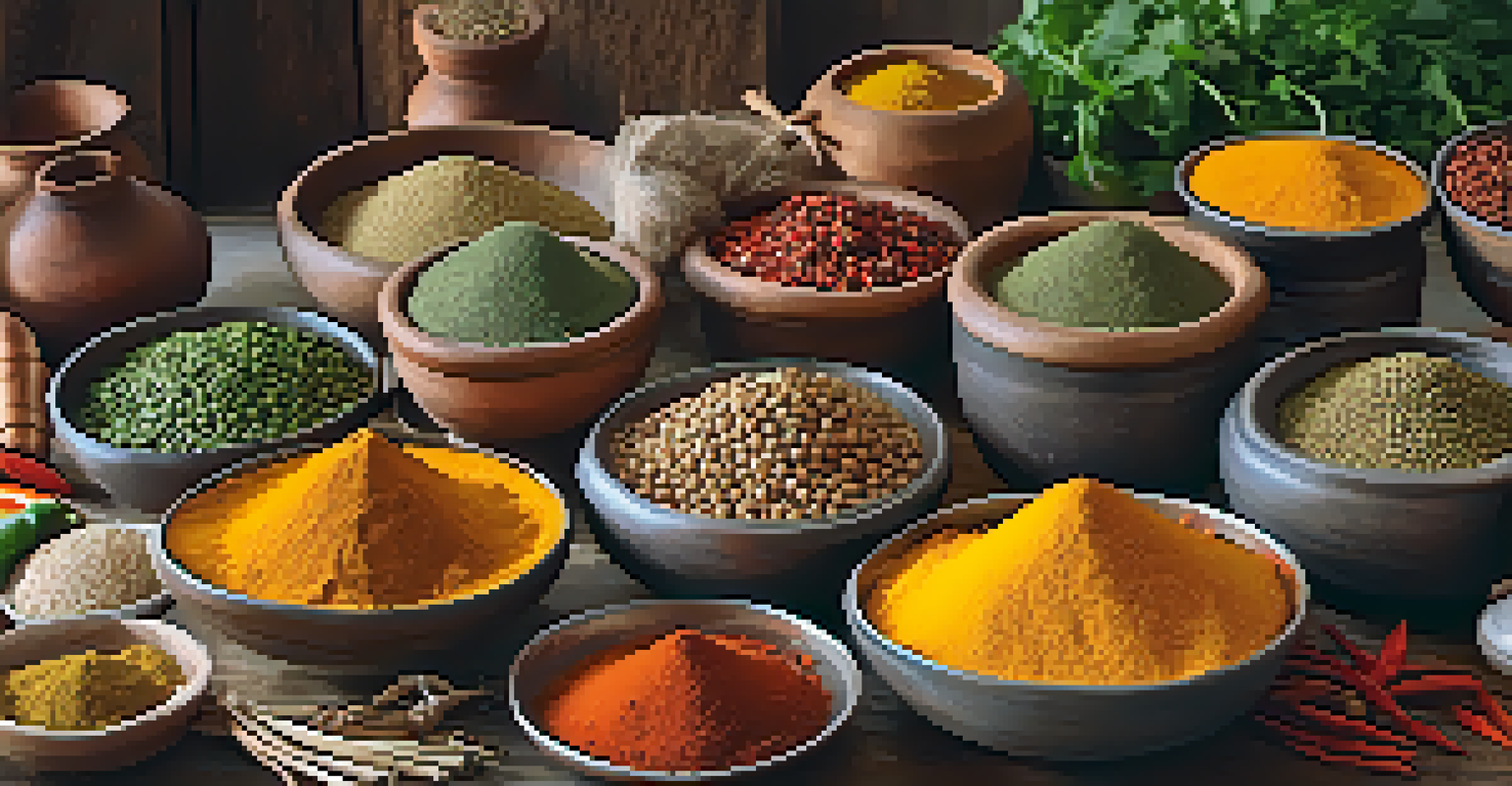Heritage Recipes: Preserving India's Culinary Traditions

The Importance of Heritage Recipes in Indian Culture
Heritage recipes are more than just food; they are a reflection of India's diverse culture and history. Each recipe carries stories, traditions, and memories passed down through generations, making them a vital part of our identity. These dishes often represent regional ingredients and cooking methods, showcasing the rich tapestry of India's culinary landscape.
Food is our common ground, a universal experience.
In many families, cooking traditional dishes is a cherished ritual that fosters connection and belonging. It’s common for grandparents to teach their grandchildren family recipes, ensuring that these culinary secrets are not lost. This transfer of knowledge emphasizes the role of food in maintaining familial bonds and cultural continuity.
By preserving these recipes, we not only honor our ancestors but also promote the significance of sustainable cooking practices. Many heritage recipes utilize local ingredients, encouraging us to appreciate and support our farmers while reducing our carbon footprint. In this way, heritage cooking aligns with contemporary values of sustainability and health.
Exploring Regional Variations in Indian Cuisine
India's vast geography and cultural diversity contribute to a wide array of regional dishes. From the spicy curries of the South to the rich, creamy gravies of the North, every region has its unique flavors and preparation techniques. Exploring these variations can be a delightful culinary adventure, as each dish tells a story of its origin.

For instance, the use of mustard oil in Bengali cuisine contrasts sharply with the coconut oil favored in Kerala. These regional distinctions are not just about taste; they reflect the local climate, available resources, and historical influences that have shaped cooking practices. Understanding these differences enriches our appreciation for Indian cuisine.
Heritage Recipes Reflect Culture
Heritage recipes are vital to Indian identity, carrying stories and traditions that connect generations.
As we delve into regional recipes, we uncover the profound connections between food and culture. Each recipe carries with it the essence of its region, from the spices used to the rituals surrounding its preparation. This exploration invites us to celebrate the diversity present within Indian culinary traditions.
Key Ingredients That Define Indian Heritage Recipes
The heart of Indian cooking lies in its vibrant and diverse ingredients. Spices like turmeric, cumin, and coriander form the backbone of many traditional dishes, enhancing flavor while offering health benefits. These ingredients are not just staples; they are steeped in history and are central to the identity of regional cuisines.
Cooking is like love. It should be entered into with abandon or not at all.
In addition to spices, ingredients such as lentils, rice, and seasonal vegetables play crucial roles in creating wholesome meals. For example, dal (lentils) is a staple across India, prepared in numerous ways, each unique to its region. This versatility illustrates how simple ingredients can be transformed into cherished family recipes.
Moreover, many heritage recipes emphasize the use of locally sourced and seasonal ingredients, reflecting a deep respect for nature. This approach not only promotes sustainability but also highlights the importance of eating in harmony with the environment. By understanding these ingredients, we can better appreciate the culinary traditions they represent.
The Role of Rituals in Cooking Heritage Recipes
Cooking heritage recipes often involves rituals that elevate the experience beyond mere meal preparation. These rituals can include everything from specific prayer offerings to the meticulous selection of ingredients. Such practices imbue the cooking process with a sense of purpose and connection to tradition.
For example, in many households, the preparation of dishes for festivals involves elaborate rituals that are as important as the food itself. These rituals can vary from region to region, showcasing the rich tapestry of beliefs and customs across India. By participating in these rituals, families reinforce their cultural identity and create lasting memories.
Regional Diversity in Indian Cuisine
India's diverse geography and culture create unique regional dishes, each with its own flavors and cooking methods.
Additionally, the communal aspect of cooking heritage recipes fosters a sense of togetherness. Families often come together to prepare traditional meals, sharing stories and laughter as they work side by side. This shared experience not only strengthens bonds but also keeps culinary traditions alive for future generations.
Modern Adaptations of Traditional Recipes
As society evolves, so does the way we approach traditional cooking. Many chefs and home cooks are finding innovative ways to adapt heritage recipes to fit contemporary tastes and dietary needs. This creative fusion can breathe new life into classic dishes while still honoring their origins.
For instance, traditional methods of cooking can be combined with modern techniques, such as sous-vide or air frying, to offer healthier alternatives. This not only makes the recipes more accessible but also encourages experimentation in the kitchen. The result is a delightful blend of old and new that appeals to a broader audience.
However, while adapting recipes, it's essential to maintain the essence of the original dish. The challenge lies in preserving the core flavors and techniques while embracing new ideas. This balance allows us to celebrate our culinary heritage while also making it relevant in today’s fast-paced world.
Collecting and Preserving Family Recipes
One of the best ways to keep culinary traditions alive is by actively collecting and preserving family recipes. This can be done through simple methods, such as writing down recipes from relatives or recording cooking sessions. These efforts not only create a tangible archive but also spark conversations about family history and traditions.
In today's digital age, technology can play a significant role in this preservation process. Families can create blogs, social media pages, or even digital cookbooks to share their heritage recipes with a wider audience. This not only honors family traditions but also invites others to appreciate and learn from them.
Preserving Culinary Traditions
Collecting and sharing family recipes helps keep culinary traditions alive and fosters a deeper appreciation for heritage.
Moreover, engaging with community initiatives that focus on preserving culinary heritage can be incredibly rewarding. Local food festivals, cooking classes, and workshops often celebrate traditional recipes, providing opportunities to connect with others who share a passion for food. These collective efforts ensure that our culinary traditions remain vibrant and relevant.
The Future of India's Culinary Heritage
As we look to the future, the preservation of India's culinary heritage remains crucial. With globalization and rapid urbanization, many traditional recipes are at risk of being forgotten. However, the growing interest in authentic and local cuisine presents a unique opportunity to revitalize these traditions.
New generations are increasingly recognizing the value of their culinary heritage, often seeking to learn about traditional cooking methods and recipes. This resurgence of interest can lead to a renewed appreciation for the stories and cultural significance behind each dish. By engaging with this culinary past, we can ensure its relevance in today's fast-paced world.

Ultimately, the future of India's culinary heritage lies in our hands. By actively preserving, sharing, and celebrating these recipes, we not only honor our ancestors but also contribute to a richer and more diverse culinary landscape for future generations. Together, we can keep these traditions alive and thriving.